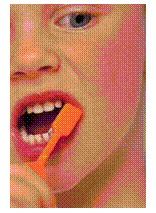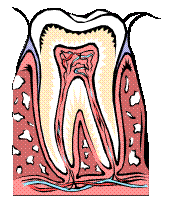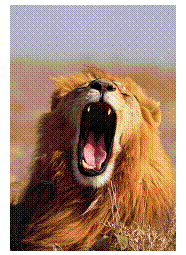Managing a Moving Target Terms
Because your child is constantly growing, we’re constantly chasing down changes as we treat your child’s craniofacial condition. When we examine your child, we use specific terms to describe the latest developments, the likely causes, and what we can do about it. Help yourself help your child by understanding the oral, facial, and soft tissue issues we take into consideration as he or she grows.

The Growing Mouth, The Growing Face & The Developing Nervous System
Alveolar Arch Collapse
Refers to the condition in which the supportive bony arch holding the upper teeth (the alveolus) is too narrowly formed to contain the proper number of teeth and to correspond with the lower jaw.
Anterior Crossbite
Refers to the condition in which your child’s upper front teeth land on one side or the other of the lower set of teeth when biting down; this may involve an area of one or more teeth.
Bruxism
Refers to the damaging habit of unconsciously, tightly clenching the teeth; often at night or during stress.
Closed Bite
Refers to the condition in which your child’s upper front teeth land distinctively far forward of the lower set of teeth; if the upper teeth completely cover the lower teeth while at rest, we call this a closed ‘deep’ bite.
Crossbite
Refers to the condition in which some of the child’s upper teeth rest inside of the lower teeth when biting down.
Crowding
Refers to the condition in which many of your child’s teeth erupt into a space that is too small for all of them to fit comfortably.
Crown Angulation
Refers to a tooth adjustment movement in which we tip the tooth root either forward or backward to correct the tooth crown angle.
Crown Inclination
Refers to a tooth adjustment movement in which we tip the tooth root toward the cheeks and lips,
or toward the tongue/roof of the mouth area, to correct the tooth crown angle.
Decalcification
Refers to the condition of losing or having lost critical calcium from the teeth, weakening them and leaving them more easily prone to decay.
Dentition
Refers to the way in which your child’s teeth are arranged.
Diastema
Refers to the condition in which two teeth have a space in between instead of lining up right next to each other.
Drift
Refers to the unfavorable condition in which teeth we’ve moved and/or adjusted move back toward their original position or in another direction due to lack of retainer or other unforeseen pressures.
Ectopic Eruption
Refers to the condition in which a tooth has come through the gums into an improper position, angle, or orientation.

Edentulous
Refers to the condition in which a person is missing the entire upper and/or lower set of teeth.
Exfoliate/Erupt
Refers to the process of losing baby teeth followed by permanent ones coming in through your child’s gums and into position.
Extrusion
Refers to the natural growth of a tooth in the direction of eruption; growing until coming into
contact with another tooth; we can perform mechanical extrusion if a tooth needs to be pulled
farther out from its eruption point in the gums.
Flared Teeth
Refers to the condition in which your child’s upper teeth are flared out toward the lip, or “lingually” (lingue = tongue, ally= of the, toward, in the direction of).
Gingival Hypertrophy
Refers to the condition in which the gum tissue around your child’s teeth swells and enlarges due to poor oral health habits (gingi= gum tissue; hyper= over, excess; trophy= growth).
Gingivitis
Refers to the condition in which your child’s gum tissue is irritated and inflamed (red, slightly swollen, tender) as a result of careless, rough, or inadequate brushing; this is often the first visible sign of gum disease (gingiva = gums; itis= infection, irritation).
Impacted Tooth
Refers to the condition in which a tooth is unable to come in or erupt due to blockage –
usually due to crowding of other teeth.
Inclination
Refers to the tilt of a tooth – its lengthwise angle in reference to a specific plane.
Intrusion
Refers to the condition in which a tooth moves partially back into the supporting bone.
Lip Incontinence
Refers to the condition in which your child’s lips do not naturally remain closed when resting; protruding front teeth or a long face may cause this.
Malocclusion
Refers to the condition in which your child’s upper and lower jaws/teeth do not fit together or
line up evenly together (mal= poor, bad; occlude= the bite, how top and lower teeth line up);
we refer to three levels of severity:
Class I
The upper and lower jaws/teeth do not meet properly in the frontal area of the arch, due to too many teeth, widely spaced teeth, an overbite, an open bite, a posterior crossbite, or an anterior crossbite.
Class II
The upper and lower jaws do not fit together as a result of either protruding upper front teeth, or of the lower jaw being considerably farther back in reference to the upper jaw.
Class III
The upper and lower jaws/teeth do not meet properly because of protruding lower teeth, or
because the lower jaw is positioned farther back than the upper jaw.
Mixed Dentition
Refers to the condition in which both baby and permanent teeth are in your child’s mouth;
usually occurs throughout the span of 6 to 10 years of age. A cleft lip palate condition can
delay the eruption of baby teeth and/or permanent teeth in specific areas of the mouth;
therefore the mixed dentition stage range can vary greatly from one patient to another.
Occlusion
Refers to the fitting together of the upper and lower jaw when biting down; can also mean the position of the jaws themselves.

Open Bite
Refers to the condition in which the upper and lower jaws/teeth cannot come together; if the back teeth cannot meet, it’s a posterior open bite; if the front teeth cannot, it’s an anterior open bite.
Overbite
Refers to the condition in which your child’s upper front teeth/jaw come farther forward than the lower teeth/jaw; the overbite can be straight up and down, or the upper teeth stick out forward at an angle.
Overjet
Refers to the condition in which the upper teeth stick out farther than the lower teeth/jaw, in a horizontal position.
Retruded
Refers to the condition in which your child’s front teeth are angled slightly in toward the
back of the mouth, or “lingually” (lingue= tongue, suffix ally = of the, toward
the).
Rotation
Refers to the tooth movement in which the tooth turns partially around compared to its normal
position and comes in through the dental ridge while rotated.
Posterior Crossbite
Refers to the condition in which the upper back teeth on either side land to one side of the lower back teeth when your child bites down; it may include a single tooth or many in an area.
Rotate
Refers to the condition in which a tooth erupts in a turned position instead of aligning with the line of teeth in the alveolar ridge.
Spee
Refers to the curve of the biting plane of where the teeth touch when your child bites down.
Tipping
Refers to the adjustment or tooth movement we do to correct the tooth crown angle; we may tip the tooth root toward the lip (labially) or toward the tongue (ligually): labia= lip; lingue = tongue; ally = of the, toward, or in the direction of.
TMJ
Refers to the temporomandibular joint: “temporo” = temple; “mandibular” =lower jaw; “joint” =point of joining. Your child’s TMJ is the moving segment where the temporal bone and lower jaw bone meet, connecting your jaw and skull. Some people use the word TMJ to refer to the painful misalignment and ongoing pain spasms that occurs in the muscles connected to the temporomandibular joint.
Torque
Refers to the rotation of a tooth on the long axis moving the root of the tooth toward the
tongue (i.e., in a buccal or labial direction).
Translation
Refers to a tooth movement in which the entire tooth moves forward or backward without tipping or rotating.
Underbite
Refers to the condition in which the lower front teeth and jaw are positioned farther forward than the upper jaw.
Velopharyngeal ‘Closure’, ‘Incompetence’, or ‘Insufficiency’
Each term refers to your child’s ability to close off the inner nose area from the mouth area, using the palatal muscles and those in the back of the throat. “Closure” indicates a normal position where there is a leak-proof seal between the two areas; “incompetence” means that the related muscles aren’t working properly to control and/or close the velopharynx; “insufficiency” means that the soft palate is not long enough to allow complete closure of the nose and mouth areas.